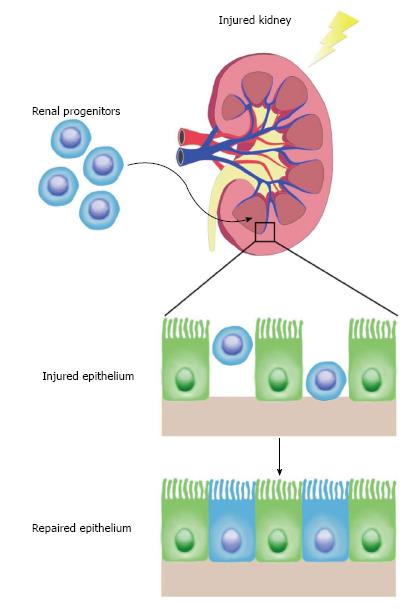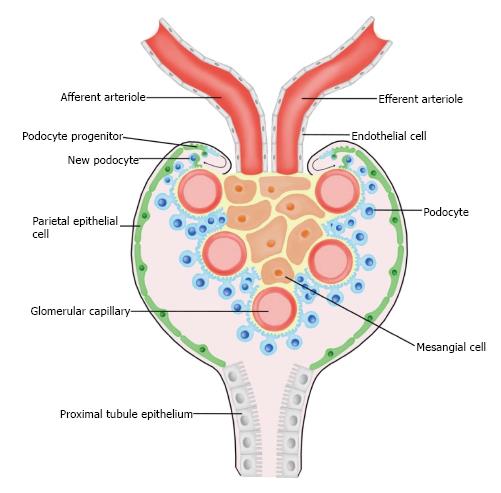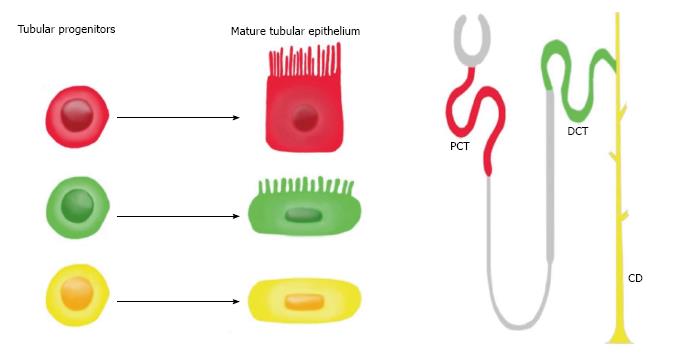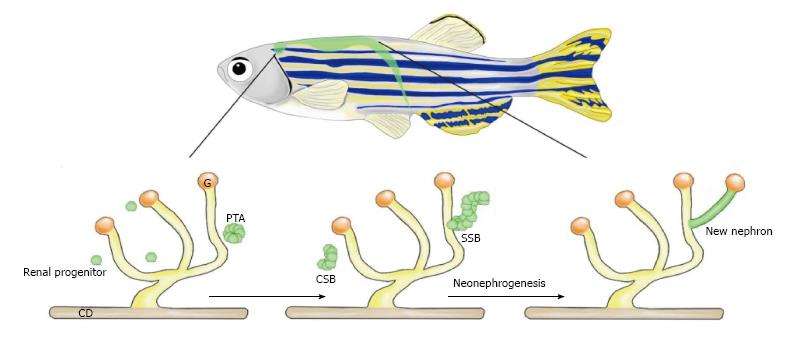Copyright
©The Author(s) 2016.
World J Stem Cells. Nov 26, 2016; 8(11): 367-375
Published online Nov 26, 2016. doi: 10.4252/wjsc.v8.i11.367
Published online Nov 26, 2016. doi: 10.4252/wjsc.v8.i11.367
Figure 1 The progression of kidney organogenesis in mammals.
The MM is derived from the IM. The MM condenses to form the CM, a renal progenitor population. These progenitors receive signals to self renew (dark green) or differentiate (light green). Cells receiving differentiation signals are organized into an epithelialized RV. Upon further maturation, these cells form a CSB, then an SSB, and finally the N. IM: Intermediate mesoderm; MM: Metanephric mesenchyme; UB: Ureteric bud; CM: Cap mesenchyme; RV: Renal vesicle; CSB: Comma-shaped body; SSB: S-shaped body; N: Nephron; CD: Collecting duct.
Figure 2 Regenerative capacity of adult renal progenitors.
Proposed adult renal stem cells were isolated and transplanted into hosts with injured kidneys. These progenitors homed to the site of injury and repopulated the renal tubular epithelium robustly. This supports a model in which an adult stem cell population contributes to kidney regeneration after acute injury.
Figure 3 A model of podocyte maintenance and regeneration.
Parietal epithelial cells (green) line the inside of Bowman’s capsule, and are suggested to serve as a renal progenitor population. Upon acute injury, parietal epithelial cells have been observed to give rise to fully differentiated podocytes (blue).
Figure 4 The fate of tubular progenitors.
Tubular progenitors are believed to be involved in renal tissue maintenance and regeneration. This stem cell population is lineage-restricted to a specific segment of the nephron. For example, the red progenitor is predestined to become PCT, the green progenitor is predestined to become DCT, and the yellow progenitor is predestined to become CD. PCT: Proximal convoluted tubule; DCT: Distal convoluted tubule; CD: Collecting duct.
Figure 5 Neonephrogenesis in the adult zebrafish.
Adult zebrafish possess the unique ability to generate new nephrons during adulthood. Neonephrogenesis in zebrafish mimics the cellular dynamics of nephrogenesis during mammalian kidney development. Renal progenitors cluster to create a PTA. This aggregate changes morphology as it first forms a comma-shape followed by an S-shape. The SSB differentiates into specific cell types that comprise the blood filter and tubules of a mature nephron. CD: Collecting duct; G: Glomerulus; PTA: Pre-tubular aggregate; CSB: Comma-shaped body; SSB: S-shaped body.
- Citation: Chambers BE, Wingert RA. Renal progenitors: Roles in kidney disease and regeneration. World J Stem Cells 2016; 8(11): 367-375
- URL: https://www.wjgnet.com/1948-0210/full/v8/i11/367.htm
- DOI: https://dx.doi.org/10.4252/wjsc.v8.i11.367













